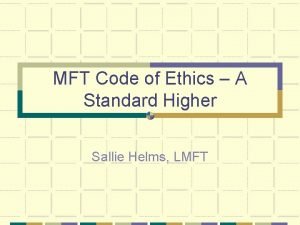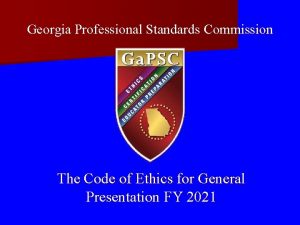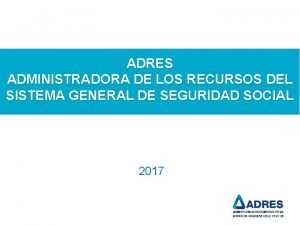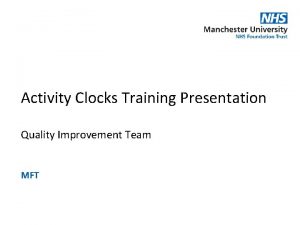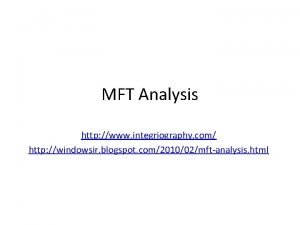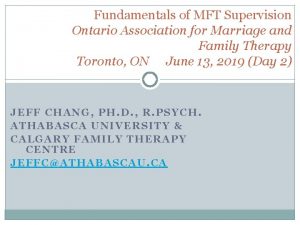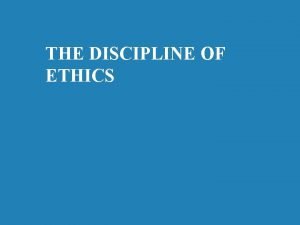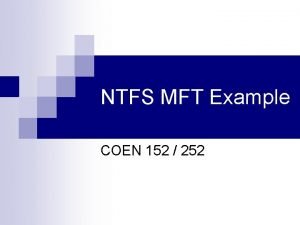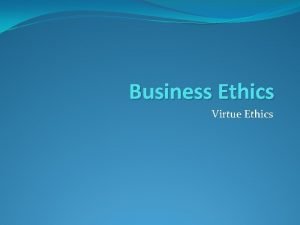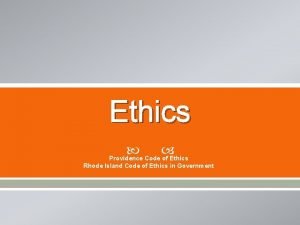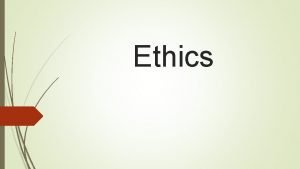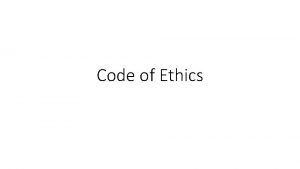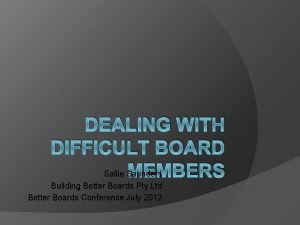MFT Code of Ethics A Standard Higher Sallie















- Slides: 15

MFT Code of Ethics – A Standard Higher Sallie Helms, LMFT

Introduction The purpose of this discussion is to invite participants to answer the challenge of the AAMFT Code of Ethics: “If the AAMFT Code of Ethics prescribes a standard higher than that required by law, marriage and family therapists must meet the higher standard of the AAMFT Code of Ethics. ” Sallie helms is licensed to practice marriage and family therapy in Texas and Georgia.

Topics of Discussion Share George Pulliam’s “Words of Wisdom”. Listen to a selection from Malcolm Gladwell’s book, Blink, and discuss how it relates to the topic of ethics. Discuss “Tips for Maintaining an Ethical Practice, ” an AAMFT member resource. Participate in a conversation regarding the ethical dilemmas and issues described in the Journal of Strategic Therapy article.

Words of Wisdom* What’s legal isn’t necessarily ethical. What’s ethical isn’t necessarily legal. George Pulliam nearly always goes with the ethical. “If you’re going to violate the rule, at least know what you are violating. ” *(Pulliam, 2005)

Blink: The power of Thinking Without Thinking* Thin Slicing: the ability to extract, in an instant, the handful of features in any situation that are crucial to making a judgment. John Gottman: psychologist who developed the concept of “thin slicing. ” Gottman has developed the Specific Affect, or Spaff, code for predicting the success or failure of marital relationships by picking out certain telltale signs.

Blink, continued Levinson’s study: l l “Next time you meet a doctor, and you sit down in his office, and he starts to talk… If you have the sense that he isn’t listening to you, that he is talking down to you, and that he isn’t treating you with respect, listen to that feeling. You have thin sliced him and found him wanting. ” “In the end, it comes down to a matter of respect, and the simplest way respect is communicated is through the tone of voice. ” *(Gladwell, 2005)

Tips for Maintaining an Ethical Practice* Don’t practice in isolation l l Make it a habit to consult with trusted sources of professional guidance and insight on a regular basis and as needed when you are unsure what to do. Use instant self-check: “Would I feel comfortable if my professional peers could see what I’m doing or consider doing? ” Remember, ethical practice doesn’t require you to be perfect, but to appropriately attempt to determine the best course of action and then follow through.

Tips… continued Listen to your intuition Protect therapeutic relationship. Take care of yourself. Know the legal and ethical duties that apply to your practice.

Tips… continued Keep learning The best therapists pursue lots of continuing education for its own sake. Doing so will help you: l l l Know firsthand the evolving standards of care in the field. Be more effective as you competencies grow. Increase the value of your professional services. Expand your network of colleagues. Keep your career fresh, interesting and satisfying. *www. aamft. org

Elements of a Collaborative Conversation* Validation: Have respect for, be humble, listen, and maintain coherence with the client’s story – promote self-confirmation. Client’s story takes center stage: Be curious, ask questions that lead to other questions, not answers. Client authors their own story: Create and safeguard room for the client to develop their own views; let them rewrite their own story. Information: Client and therapist together create knowledge, knowledge that is unique and specific to the client.

Elements… continued. Intervention: Avoid across-the-board diagnoses, goals, and strategies for reaching those goals. Public: Make invisible therapist ideas and prejudices visible; keep them open to question and change. Understanding: Don’t know, assume, or fill in the blanks too quickly. *(Anderson, 1992)

Some Considerations in Using the Reflecting Process Goal: Maximize the numbers of ideas Keep the reflecting process short. Stay coherent with the various narratives as developed by the clients. Share ideas with each other. Openly and briefly share the different ideas one had while listening. This is not a “Sherlock Holmes” detective hunt for diagnostic understanding that makes sense of what is wrong.

Reflecting Process, continued This is not the place for a “staff meeting” mentality. Keep in mind the temptation to find a positive connotation of everything that is heard. Positive connotation often amounts to little more than trying to talk people out of their problem. Keep in mind that negative connotation of any major position of any participant (including one’s colleagues) is destructive to the process of opening space for a conversation.

Reflecting Process, continued The expertise is in our clients. Our expertise is in developing a conversation about that which is relevant and central for them. *(Anderson & Goolishian, 1989)

Discussion of JST article How did the article challenge your thoughts regarding ethical practice? What would you have done differently, as an intern facing these ethical dilemmas? What “fresh ideas” will you take with you as a result of this discussion?
